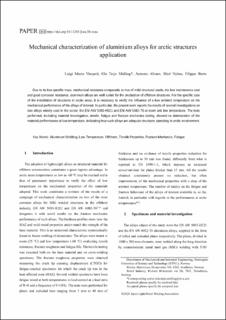Mechanical characterization of aluminum alloys for arctic structures application
| dc.contributor.author | Viespoli, Luigi Mario | |
| dc.contributor.author | Midling, Ole Terje | |
| dc.contributor.author | Alvaro, Antonio | |
| dc.contributor.author | Nyhus, Bård | |
| dc.contributor.author | Berto, Filippo | |
| dc.date.accessioned | 2020-03-24T13:46:22Z | |
| dc.date.available | 2020-03-24T13:46:22Z | |
| dc.date.created | 2020-03-23T11:00:37Z | |
| dc.date.issued | 2020 | |
| dc.identifier.issn | 2186-618X | |
| dc.identifier.uri | https://hdl.handle.net/11250/2648388 | |
| dc.description.abstract | Due to its low specific mass, mechanical resistance comparable to that of mild structural steels, the low maintenance cost and good corrosion resistance, aluminum alloys are well suited for the production of offshore structures. For the specific case of the installation of structures in arctic areas, it is necessary to verify the influence of a low ambient temperature on the mechanical performance of the alloys of interest. In particular, the present work reports the results of several investigations on two alloys widely used in the sector, the EN AW 5083-H321 and EN AW 6082-T6 at room and low temperature. The tests performed, including material investigation, tensile, fatigue and fracture mechanics testing, showed no deterioration of the material performances at low temperature, indicating how such alloys are adequatestructures operating in arctic environment | en_US |
| dc.language.iso | eng | en_US |
| dc.publisher | Japan Light Metal Welding Association | en_US |
| dc.title | Mechanical characterization of aluminum alloys for arctic structures application | en_US |
| dc.type | Journal article | en_US |
| dc.description.version | acceptedVersion | en_US |
| dc.source.journal | Journal of Light Metal Welding | en_US |
| dc.identifier.cristin | 1802924 | |
| dc.description.localcode | Ⓒ2020Japan Light Metal Welding Association. This is the authors’ accepted and refereed manuscript to the article. | en_US |
| cristin.ispublished | true | |
| cristin.fulltext | postprint |
